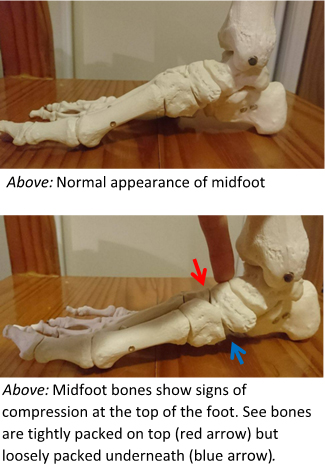Dorsal interosseous compression syndrome is felt as pain on the top of your foot. It usually affects people with higher arches than what is considered normal or in those with hypermobility (or ligaments that are more loose or stretchy) which allows more movement in the joints of the foot than usually seen.
those with hypermobility (or ligaments that are more loose or stretchy) which allows more movement in the joints of the foot than usually seen.
Many of the bones in your feet meet at the top of your foot above your arch. They articulate with each other when you walk. These bones can jam together as your arch flattens when you walk. In other words, the bones are forced closer together so compressing the tissues and causing pain. Because of this compression, these people may be more susceptible to midfoot osteoarthritis.
Dorsal interosseous compression syndrome often coexists or is confused with midfoot osteoarthritis. Sometimes an x-ray may be used to identify or rule out midfoot osteoarthritis. Dorsal interosseous compression syndrome is easier to manage when not complicated by osteoarthritis as osteoarthritis is a degenerative condition and cannot be reversed.
Management:
Treatment for dorsal interosseous compression syndrome is to limit how much the bones are forced together. Supportive shoes are a useful starting point.
If a person has a flexible foot and a high arch, the podiatrist may prescribe an orthotic to support the midfoot and prevent the collapse that causes the compression. The podiatrist may also add a small heel to the inside of your shoe. This will also reduce compression through your midfoot.
People with flat feet can also get dorsal interosseous compression syndrome. The treatment is the same. Using padding or orthotics, the midfoot should be supported to prevent compression.
If osteoarthritis coexists, the foot may not be very flexible and so only minimal midfoot support can be provided. In such cases, the podiatrist will provide what midfoot support your foot is able to tolerate, as well as addressing other factors that may be contributing to the pain. Further management revolves around managing the symptoms of the osteoarthritis.

Comments are closed.